From the Ninth Century to The Twelfth Century, Islamic Culture Flourished and Crystallized into What We Now Recognize as Islam
By
Eman M. Elshaikh
20 July
2020
Overview
Towards the end of the Abbasid caliphate, the formerly vast and united
Islamic empire became fragmented and decentralized.
Many different groups ruled areas previously held by the Abbasids.
Religious institutions became more defined during this period as state
power waned.
Trade contributed to the spread of Islamic culture and led to a growing
feeling of internationalism.
From the
ninth century to the twelfth century, Islamic culture flourished and
crystallized into what we now recognize as Islam. The military expansions of
the earlier period spread Islam in name only; it was later that Islamic culture
truly spread, with people converting to Islam in large numbers.
Also
Read: A Lesson in Tolerance: The Ibadis of Oman
This spread
of Islamic culture was facilitated by trade, missionaries, and changes in the
political structure of Islamic society. As a result, we encounter multiple
different interpretations of Islam across many different Islamic societies.
Political
Decentralization and Fragmentation
The
Abbasids’ massive empire—spanning over four thousand miles—was impressive, but
very difficult to maintain. As people converted to Islam, tax revenue collected
from non-Muslim subjects dwindled, and the Abbasid court could no longer
sustain its expenditures. Abbasid religious authority was also wavering as a
more powerful class of religious scholars at the helm of new religious
institutions challenged the legitimacy of the system of caliphate.
Ultimately,
the highly centralized Abbasid caliphate fragmented into multiple smaller,
independent political structures. These new political structures diminished
Abbasid power.
It was
perhaps this political decentralization and destabilization that led to the spread
of Islam beyond the massive Abbasid empire’s borders. Regional rulers, who did
not have to manage such vast territories, were able to expand more fruitfully
in single directions. For example, the Fatimids and Berber dynasties in North
Africa were able to expand into Sub-Saharan Africa, and the Ghaznavids
stretched farther into India.
How did
the Abbasid empire change over time?
How did
these changes contribute to the spread of Islam?
The
formation of diverse religious and state institutions
Modern Islam
is divided into many sects. While the tensions that led to the development of
these sects were certainly present in the early history of Islam, it took
centuries for different religious interpretations to become organized into
clear schools of thought. As scholars compiled histories, laws, and
philosophical treatises, the main schools of legal thought emerged.
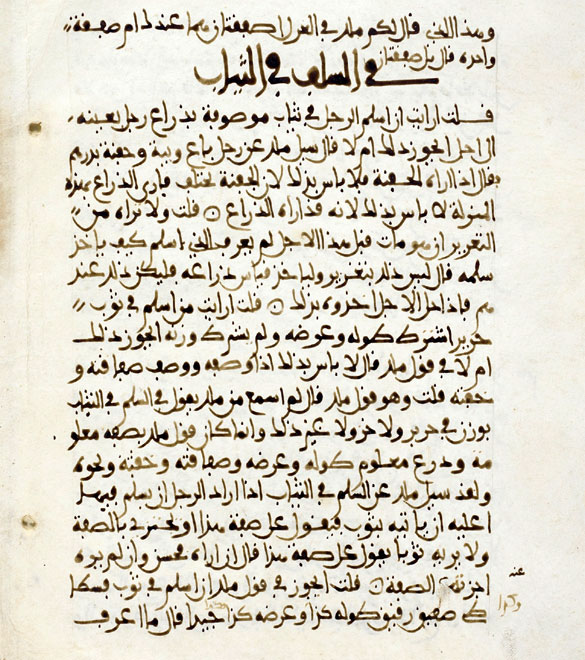 A
page from a manuscript on Islamic law from Spain, first half of the 11th
century. Image credit: Wikimedia Commons.
A
page from a manuscript on Islamic law from Spain, first half of the 11th
century. Image credit: Wikimedia Commons.
-----
Just as
religious institutions were gaining stability, political establishments were
becoming even more unstable. As Muslim Turks migrated into the Islamic empires,
other groups invaded, including the Mongols. Another source of political
instability was the confrontation between Muslims and Christians in Western
Europe, with the inquisition, the Crusades.
In the
shadow of these political upheavals, Islamic political structures transformed,
and new leaders from beyond the traditional Arab Muslim elite emerged. Kurdish
leaders, like Saladin of the Ayyubid dynasty, were incredibly influential.
Mamluk slave-soldiers of Turkish origin were also gaining power.
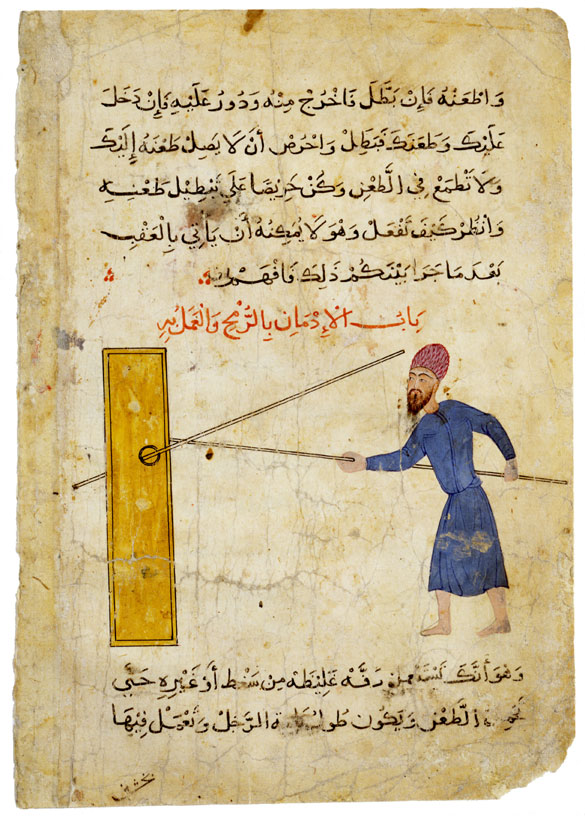 A drawing showing a man practicing with a lance, a long weapon with a
wooden shaft and a pointed steel head, formerly used by a horseman in charging.
The man has a beard and wears a red garment on his head. There is text in the
Arabic script around the drawing.
A drawing showing a man practicing with a lance, a long weapon with a
wooden shaft and a pointed steel head, formerly used by a horseman in charging.
The man has a beard and wears a red garment on his head. There is text in the
Arabic script around the drawing.
A depiction of a Mamluk training with a lance in the early 16th century.
Image credit: Wikimedia Commons.
------
Eventually,
multiple small states emerged where the Abbasids once ruled exclusively. The
Abbasids’ five-century existence finally came to an end with the Mongol sacking
of Baghdad in 1258.
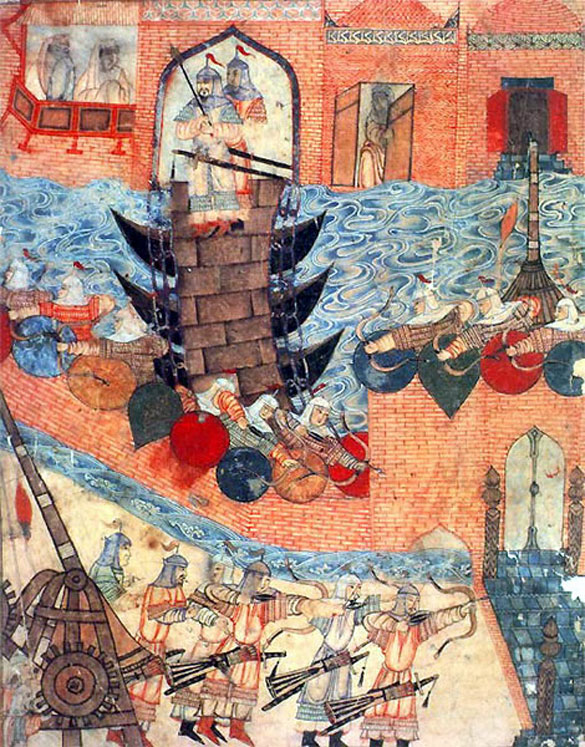 A painting depicting a battle. Warriors are crossing water and land, charging
a fortified area,.
A painting depicting a battle. Warriors are crossing water and land, charging
a fortified area,.
A painting depicting the siege of Baghdad by the Mongols in 1258. Image
credit: Wikimedia Commons.
-----
After the
fall of the Abbasids, alternative social and political structures filled the
vacuum. Sufi religious institutions were one such alternative structure. Sufi
missionaries were responsible for many conversions in sub-Saharan Africa and in
South and Southeast Asia.
Conversion
from other religions like Christianity and Judaism was relatively easy and
quick due to shared religious ideas. Conversion from pagan and polytheistic
religions, however, was more difficult. Sufi missionaries navigated these
difficulties adeptly, making Islam appealing by assimilating it into existing
religious traditions.
This
assimilation is evident in the mix of Islamic traditions with pre-Islamic
belief systems in syncretic religious systems. For example, Kebatinan, a
religion that appeared in modern-day Indonesia around the sixteenth century
combined animistic, Buddhist, Hindu, and Islamic—especially Sufi—beliefs and
practices.
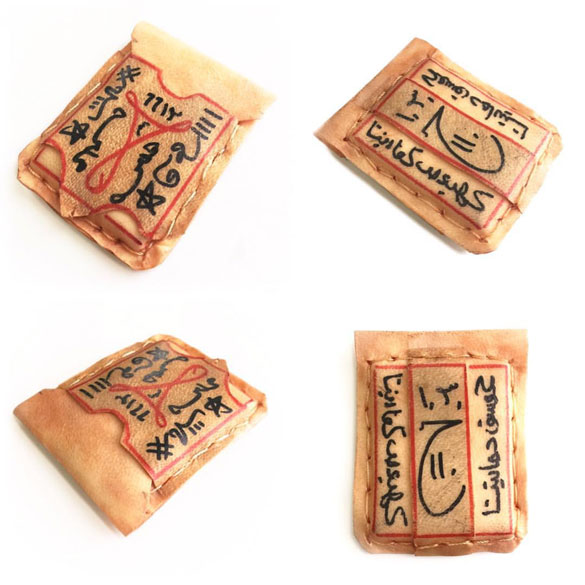 Four small objects with inscriptions in Arabic letters.
Four small objects with inscriptions in Arabic letters.
A kebatinan talisman, which is meant to increase spiritual power. Image
credit: Flickr (CC BY 2.0).
----
By the late
Abbasid period, Muslim rule was no longer an Arab phenomenon. Muslim Kurdish,
Persian, Turkish, Mongol, and Afghan leaders secured power in places as far
apart as modern-day Turkey and modern-day northern India. From there, Islam
spread to modern-day Malaysia and Indonesia.
Indeed, it
was the later Persian Safavid and Turkish Ottoman empires, neither of which was
Arab, out of which the modern Islamic world was carved.
How did the
ethnic character of the Muslim Empires change over the course of the Abbasid
caliphate?
What Is
One of The Ways That Syncretic Islamic Traditions Emerged?
Missionaries
and political expansion moved Islamic culture, but Islamic culture also
travelled through trade. Caravans, groups of travellers who used camels to
transport themselves and goods across land, were critical to the spread of
Islam. Just as camels enabled the first caliphs to expand their empires,
caravans allowed the Abbasids and other powers to expand their civilizations
and enrich their cultures by linking provinces which were far from one another.
Advanced road networks enabled caravans filled with soldiers, pilgrims, envoys,
merchants, and scholars to travel across vast territories.
Along these
trade routes, merchant communities developed. Muslims controlled parts of the
western silk road and were influential on trans-Saharan trade routes. They also
were powerful entities in maritime trade in the Red Sea, Persian Gulf, and
Indian Ocean.
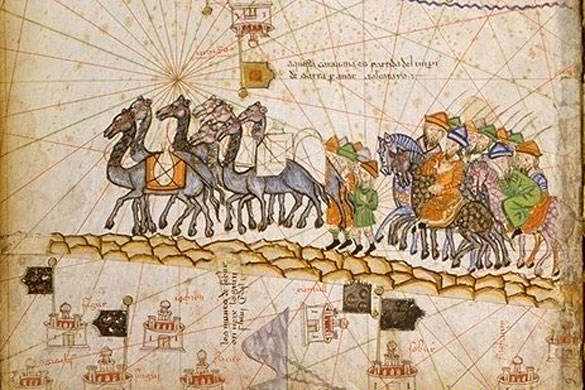 A drawing of a group of people traveling on horseback in a straight
line.
A drawing of a group of people traveling on horseback in a straight
line.
A depiction of a caravan traveling along the Silk Road around the
fourteenth century. Image credit: Wikimedia Commons.
-----
While these
trade interactions undoubtedly had important ramifications, they were equally
influential in the cultural realm. They created a sense of internationalism and
multiculturalism. This cultural exchange seems obvious to our modern
sensibilities, but at the time, it was an entirely new way of thinking about
the world.
New cultural
relationships resulted in the transfer of technology, science, and other
cultural forms. For example, interaction between Arab Muslim forces and the
Tang dynasty may have resulted in the exchange of the technology of paper,
which revolutionized the Muslim world and later travelled to Europe.
Bibliography:
Berkey,
Jonathan. The Formation of Islam: Religion and Society in the Near East,
600-1800. Cambridge: Cambridge University Press, 2003.
Hoyland,
Robert G. In God's Path: the Arab Conquests and the Creation of an Islamic
Empire. Oxford: Oxford University Press, 2015.
Lapidus,
Ira M. A History of Islamic Societies. New York: Cambridge University Press,
2014.
Silverstein,
Adam J. Islamic History: a Very Short Introduction. Oxford: Oxford University
Press, 20
Original
Headline: The development and spread of Islamic cultures
Source: The Khan Academy
URL: https://newageislam.com/islamic-culture/from-ninth-century-twelfth-century,/d/122418
New
Age Islam, Islam Online, Islamic Website, African
Muslim News, Arab
World News, South
Asia News, Indian
Muslim News, World
Muslim News, Women
in Islam, Islamic
Feminism, Arab
Women, Women
In Arab, Islamophobia
in America, Muslim
Women in West, Islam
Women and Feminism
